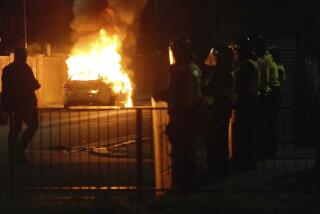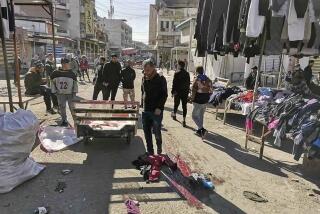Britain Hunts for Egyptian Biochemist
- Share via
LONDON — Authorities investigating the London bombings are searching for an Egyptian biochemist who allegedly rented the apartment where the explosives were assembled, and for an unnamed Briton of Pakistani descent.
As the death toll in the bombings rose to 54 on Thursday, a Scotland Yard official said the inquiry was “fast moving ... with new leads emerging literally by the hour.” Officials closed off another street in the northern city of Leeds, where a number of the suspected plotters lived, and residents said officers searched a storefront community center.
Officials have said last week’s bombings bear the hallmarks of an Al Qaeda attack, and the suspected involvement of an Egyptian added weight to the theory that the blasts aboard three subway trains and a bus were the work of an international network.
Authorities are “intensely interested” in the Egyptian, said a high-ranking European anti-terrorism official who is working with British police. “Often when you find an Egyptian in a cell in Europe, he plays the role of the little emir, the ideologue who inspires the others, the one who relays the orders.”
A city councilor in Leeds identified an apartment in the city as the apparent “bomb factory” used by the attackers. Investigators said it was rented by Magdy el-Nashar, an Egyptian. A landlord interviewed by the Yorkshire Evening Post said El-Nashar, who studied at the University of Leeds, rented the place about three weeks ago.
Police broke into the apartment Tuesday afternoon and found suspicious materials in the bathroom, prompting them to evacuate about 600 residents. Those displaced were being allowed to return late Thursday.
Little was immediately known about El-Nashar. A spokesman at North Carolina State University confirmed that a Magdy el-Nashar, 33, was a graduate student in chemical engineering for the spring semester in 2000. Associated Press quoted a university spokesman as saying that El-Nashar decided to study in Leeds instead.
Local papers in Leeds quoted neighbors as saying El-Nashar, who had recently received a PhD in biochemistry, had told them that he was leaving Britain because of a visa problem and that they had not seen him since early this month.
British investigators have described the other suspect as a Pakistani Briton with a profile similar to that of three of the alleged bombers and who has traveled extensively. No further details were available.
Although it appeared initially that the four bombers were all Britons of Pakistani descent, the investigation now indicates that one was a British convert to Islam with a Jamaican background, the high-ranking anti-terrorism investigator said. That fourth suspected bomber has been identified as Lindsey Germaine, 20, a resident of Aylesbury, about 40 miles northwest of London, the official said.
On Thursday, counter-terrorism officers scoured Germaine’s home for a second day, and the BBC said DNA samples were being taken from the house, with the intention of matching them to remains found at one of the blast sites.
The reported presence of Germaine in the bombing team struck some investigators as odd. Many Al Qaeda plots have involved multi-ethnic teams, but investigators want to understand how and why the trio from Leeds apparently joined forces with an extremist from a different background 200 miles away.
There have been cases of Jamaican British Muslims involved in terrorist plots. A prominent example is Richard C. Reid, the “shoe bomber” who tried to blow up a plane in late 2001. Reid, the son of a Jamaican immigrant, was a jail-house convert to Islam and was trained and directed by a Pakistani-dominated network. Investigators say Germaine may have followed a similar path.
And an Al Qaeda explosives expert known as “Yusuf the Jamaican” figured centrally in the suicide bombings in Casablanca, Morocco, in 2003, police say. Andrew Rowe, a British convert now in jail, allegedly prepared video CDs on bomb making that were sent to Morocco to train the 14 young militants who carried out the attacks.
Police suspect the London attacks were also the work of suicide bombers. During a lunch with foreign correspondents Thursday, Ian Blair, the chief of the Metropolitan Police, made the most direct statement about that theory, saying, “They went onto those [trains] or bus to kill and, presumably, accepted they would be killed.”
In many other suicide attacks, aspiring “martyrs” have left behind declarations of their decision -- videotaped messages or written statements, like the will of Mohamed Atta, the lead Sept. 11 hijacker.
But nothing like that has appeared here yet. Adding to the mystery, remnants of timers were found in the debris.
Blair reiterated his belief Al Qaeda played a role in the attacks, even if the orders were not issued by the network’s leaders, thought to be on the run in the Afghan-Pakistani borderlands.
“Al Qaeda clearly has the ability to provide training, to provide briefing, to provide expertise. And that I think is what has occurred here and what occurred in Madrid,” he said, referring to deadly March 2004 train bombings in the Spanish capital. “But if one is suggesting that people directly from the border of Pakistan and Afghanistan were directly involved in this, the answer is no.”
At a separate news conference, Peter Clarke, director of the Metropolitan Police anti-terrorism branch, appealed for information from anyone who may have observed Hasib Hussain, at 18 the youngest of the suspected suicide bombers, between the time he left King’s Cross Station on the morning of July 7 and when he is believed to have blown up a double-decker bus.
Clarke presented a picture of the suspected bomber, captured from a closed-circuit camera, showing the husky, tall Hussain, his face set grimly, with the backpack presumed to contain the explosives that later blew off the bus roof, killing him and 13 other passengers.
The bomb aboard the bus detonated at 9:47 a.m., nearly one hour after the three explosions on the Underground. Law enforcement sources have theorized that Hussain originally had intended to board a car on the Northern Line subway train but was prevented by delays.
At the news conference, Clarke confirmed that the bomb near Aldgate station was believed to be the work of Shahzad Tanweer, 22, of the Beeston neighborhood in Leeds. The avid cricket player had attended Leeds Metropolitan College and was from a relatively well-off family, his father owning the local fish-and-chips shop.
So far, Hussain and Tanweer are the only two suspected bombers who have been officially named, but police sources have identified Germaine as the likely bomber on the Piccadilly Line train near King’s Cross Station.
The fourth bomber has been identified by investigators as Mohamed Sidique Khan, 30, and so far they consider him the key figure among the group.
The primary school teacher, a father of an 8-month-old girl, may have commanded respect from his younger associates because they saw him as well-versed in Islamic knowledge, the high-ranking European anti-terrorism investigator said.
Investigators said there were other signs pointing to a lead role for Khan: He traveled to Pakistan several times, and he has been linked to members of a cell dismantled last year who are charged with stockpiling half a ton of explosives.
That cell of British Pakistani extremists allegedly took orders from a network in Pakistan that may have also played a role in the London attacks, British and U.S. anti-terrorism officials say.
Rotella and Daniszewski reported from London. Special correspondent Kate Parkinson in Leeds contributed to this report.
More to Read
Sign up for Essential California
The most important California stories and recommendations in your inbox every morning.
You may occasionally receive promotional content from the Los Angeles Times.













